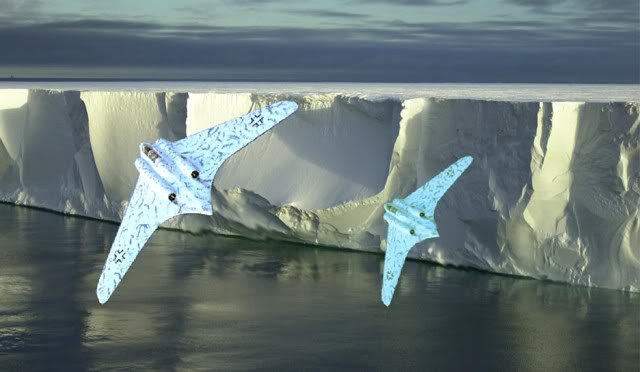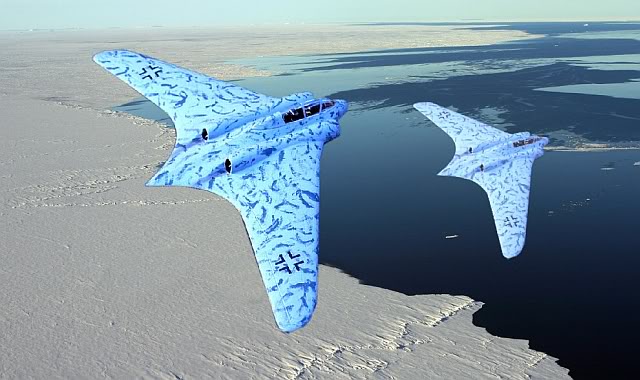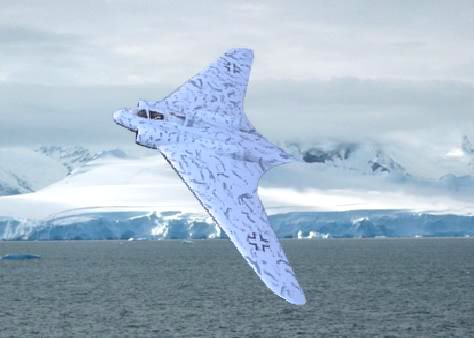Cold
War Interceptor - The Defenders of Antarktica
![]()

Two Hortens catch the low sunlight as they patrol along the Antarctic Coast, using the steep iceberg cliff-sides to provide terrain masking.
The aircraft lurched suddenly to the right, and Reppler's stomach lurched with it. "for Gods sake Vogel, the wings" Vogel's muttered response was inaudible over the intercom, but its dismissive tone was clear. "Arrogant pig!", thought Reppler in silent response. The Ho-229's bat-like wings were fabricated from carbon impregnated plywood and the damp Antarctic air was taking its toll on the older aircraft; plywood was a decidedly scarce commodity where there were no trees. But Vogel cared little for such things. A third generation German raised in Argentina, his attitude was, in Reppler's disciplined and ordered opinion, sloppy and uncommunicative.
If truth be told, it wasn't just the plywood. Most things were scarce nowadays in the Reichskolonie Antarktika. Except fuel oil, that was. The under-ice wells had been the driving force of the original base when it was established in 1938, and Herr Wegler's hugely successful mini refinery plant, carefully transported by U-boat, then reassembled beneath the ice caverns, was a perfect example of the ingenuity and success of the Fuhrer's magnificent vision. Without it, the Kolonie would have had no light, power or heat, nor would its air and land defences have been able to hold back the Allied forces that surrounded them. Nor, of course, would they have been able to mine and purify the valuable Uranium ore, needed so desperately for the V-weapon programme.
Reppler's attention was suddenly gripped by the cathode ray tube of his radar. Glowing dimly in the dark rear cockpit, he could clearly see the tell-tale green spikes of the fighters. Sea Hornets probably, from the New Zealander's fleet carriers. Reppler and Vogel had tangled with the Hornets many times before; a capable and good looking aircraft, but nowhere near as maneuverable or as fast as the Horten. In any event, their stealthy carbon impregnated wings would render them virtually invisible to the British radar. Worth watching though, but not the reason for their scramble.
Deftly squeezing the joystick, he placed a marker over the radar return and engaged the autotracking device. A much larger spike was rising at the left of the screen; that was more like it; the bombers were coming once more. His voice took on a new urgency: "Vogel, new track, sector blue six, strong, probable bomber formation. Come left 10 degrees, increase speed to 500k and climb to intercept". Vogel grunted in acknowledgement and eased open the twin jet throttles, turning a little less sharply this time onto the new course.
Their's was certainly an uncomfortable relationship in the cockpit, thought Reppler. But he knew that the LuftMarshal had a specific reason for teaming them together; he shared Reppler's suspicions of Vogel and his degenerate south american influences. Not a team player. Not entirely Aryan either. Someone to keep a close eye on, and Reppler was the man to do it. Reppler knew full well that the atomik V-weapons were nearly ready; they would soon be able to launch the decisive strike against the British and Americans, that would ignite the campaign to liberate the Fatherland from its hated Allied and Bolshevik occupiers. Those who were not a part of the great venture, the Fuhrer's vision for mankind, those like Vogel, they would not have to be tolerated for much longer.
|
|
Reppler's attention focused back on the radar; this was a new tactic from the Allies. The bombers had been constantly probing the Kolonie's defences constantly for over a week now, since the beginning of October 1946. American B-29s by day, British and Australian Lancasters by night. Mostly, they turned around once the Hortens were detected. Sometimes the defenders would get their Hortens right into the formation without being spotted, and then the fun would begin. Occasionally a few of the bombers would press on, with the carrier-based fighters joining in to escort them over the Antarctic land mass. But with Antarktika hidden almost entirely beneath the ice, they had not yet located the city, nor, thank goodness, the U-boat caverns that still provided the only link with their friends in the wider world. The Horten's early jet engines performed particularly well in the cold Antarctic air, although the damp conditions occasionally took their toll on the wooden airframes. |
Just as Reppler expected, the bomber formation was now turning away, as were the carrier based fighters. Disappointing; back to the ice runway then, and more of Vogel's insufferable arrogance in the ready room. "Targets turning away, set course vector 001 and return to base". As the aircraft made another stomach wrenching lurch to the right, Reppler was about to curse Vogel's flying yet again, when he noticed a small spike on the radar scope, still heading toward the land. A fighter ? No, too small. More likely a radio guided missile, fired in futile exasperation by the RAF. It would scorch some snow perhaps. He chuckled to himself and decided to let Vogel be. No action tonight then.
|
But Reppler was wrong. The missile did more than scorch the snow. With a blinding flash of white light, the sky ahead of them lit up abruptly, as the atomic fission armed missile detonated with a force equivalent to 100,000 tonnes of TNT. The cathode ray tube exploded in Reppler's face, adding to his blindness. The intense whiteness quickly gave way to red flame as the Horten's controls and engines faded into dark silence. "Mein Gott ! ", cried Vogel, the horror and fear in his voice clear despite the flat tone of the intercom. The aircraft lurched upwards, out of control, the plywood wing surfaces suddenly disintegrating, a moment before the devastating shock wave and hell-like wall of flame engulfed them.
The history books will tell you that World War 2 ended in 1945. It didn't. The war in Europe and the Pacific may have come to an end, but the Nazi regime had already established a well armed and self sustaining military-scientific colony, some 12,000 strong, hidden beneath the Antarctic ice. It was here that Albert Speer's grand visions of Germania would be built by hand picked Aryan scientists and workers, not in Europe. Sustained by clandestine U-boat supplies from South America, the colony thrived below the ice, as it prepared to launch the Nazi's devastating revenge. |
A Horten banks low over the Weddell Sea. |
Armed with weaponry far in advance of that used by the Allies, including the nuclear tipped V-weapon ballistic missiles, the Reichskolonie would initiate the wholesale destruction of Washington, New York, Chicago, London and Paris. The cities of Ottawa, Auckland and Canberra would eventually share in this fate, as the remnants of the Nazi's defeated armies in Europe rose together once more in revolt.
But it was not to be. Alerted by a small group of disillusioned German scientists in Berlin, the Allies began a massive, yet secret blockade of the Antarctic, co-ordinated and led from a hidden naval base built established amongst the cliffs of New Zealand's South Island. The secret war of attrition and containment lasted for nearly 2 years, whilst the leaders of the free world fretted over the best way to defeat the resurgent threat. Hidden in their well protected Antarctic stronghold, with almost unlimited fuel, abundant minerals and hydroponically grown food, the Nazis would not be defeated by normal means and their military potential grew with each passing day.
Finally, in 1947 a decision was reached. Atomic weapons would be used to enable an overwhelming and final land assault. The decision was not unanimous, as the true horror of their effects in Hiroshima and Nagasaki had become more widely appreciated. But, eventually, despite strong French objections, the ends were deemed to justify the means. As 1947's winter season in the southern hemisphere's drew to a close, the attack, codenamed Operation Highjump, began in earnest. A combined British, American and Soviet marine expeditionary force had assembled in the Falkland Islands, ready for the comparatively short hop to the Antarctic continent. A co-ordinated strike by ten separate 50 Kiloton air-launched atomic weapons was exploded over the possible sites of the Nazi base, fatally weakening the Reichskolonie's defences, destroying all electronics and exposing the damaged under-ice structures to more conventional attack.
But although the Allied victory was absolute, in the final analysis, it was pyrrhic and hollow. The residual radiation in the Antarctic soil and rain struck down many of the attacking force and it was apparent that the heavily contaminated Antarctic land mass would remain uninhabitable for many tens, if not hundreds of years. The wider effect on the planet's climate, caused by the wholesale radioactive vaporisation of the Antarctic ice sheets would be more difficult to gauge, but would be felt for generations to come; scientists estimated that cancer would become the main cause of human death in the developed world and that the climate change and global warming resulting from the atmospheric dust and steam would be irreversible. It would certainly lead to famine and plague in the fragile crops of Africa and Asia, but might even eventually threaten all life on earth. In the corridors of power it was unanimously agreed that the whole truth could not be revealed to the world, until science could understand it and offer some form of hope.
Thus it was, that one of the first acts of the newly formed United Nations Organisation was to prepare a comprehensive international Antarctic Treaty, placing the scorched and devastated Antarctic off limits to all but government meteorology scientists until the mid 21st century. The public Protocols of the treaty would tell of scientific exploration and preservation of an unspoilt continent. The hidden protocols would deal with quarantine and public deception. The real reasons for making the Antarctic off-limits would remain a secret, at least until the global warming effects of climate change were obvious, even to the lay population.
Nevertheless, eminent meteorologists estimated that this would not be for another 60 years or so; say 2010, or thereabouts.
Plenty of time to find a solution. . .

Two Hortens in close hunting formation over the Ross Ice-Pack
Copyright 2008 GENGRIZ
(if you can't see the Website Navigation Bar try this link to restore it)

